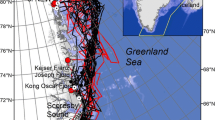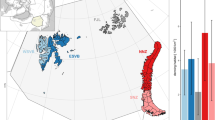Abstract
Polar bears (Ursus maritimus) in the northern Alaska region den in coastal areas and on offshore drifting ice. We evaluated changes in the distribution of polar bear maternal dens between 1985 and 2005, using satellite telemetry. We determined the distribution of maternal dens occupied by 89 satellite collared female polar bears between 137°W and 167°W longitude. The proportion of dens on pack ice declined from 62% in 1985–1994 to 37% in 1998–2004 (P = 0.044) and among pack ice dens fewer occurred in the western Beaufort Sea after 1998. We evaluated whether hunting, attraction to bowhead whale remains, or changes in sea ice could explain changes in den distribution. We concluded that denning distribution changed in response to reductions in stable old ice, increases in unconsolidated ice, and lengthening of the melt season. In consort, these changes have likely reduced the availability and quality of pack ice denning habitat. Further declines in sea ice availability are predicted. Therefore, we expect the proportion of polar bears denning in coastal areas will continue to increase, until such time as the autumn ice retreats far enough from shore that it precludes offshore pregnant females from reaching the Alaska coast in advance of denning.





Similar content being viewed by others
References
Amstrup SC (1993) Human disturbances of denning polar bears in Alaska. Arctic 46:246–250
Amstrup SC (2003) Polar bear. In: Feldhammer GA, Thompson BC, Chapman JA (eds) Wild mammals of North America. Biology, management, and conservation, 2nd edn. Johns Hopkins University Press, Baltimore, pp 587–610
Amstrup SC, Gardner C (1994) Polar bear maternity denning in the Beaufort Sea. J Wildl Manage 58:1–10
Amstrup SC, Durner G, Stirling I, Lunn NJ, Messier F (2000) Movements and distribution of polar bears in the Beaufort Sea. Can J Zool 78:948–966
Amstrup SC, McDonald TL, Durner GM (2004) Using satellite radiotelemetry data to delineate and manage wildlife populations. Wildl Soc Bull 32:661–679
Atkinson DE, Brown R, Alt B, Agnew T,Bourgeois J, Burgess M, Duguay C, Henry G, Jeffers S, Koerner R, Lewkowicz AC, McCourt S, Melling H, Sharp M, Smith S, Walker A, Wilson K, Wolfe S, Woo1 M-K, Young KL (2006) Canadian cryospheric response to an anomalous warm summer: a synthesis of the climate change action fund project “The state of the arctic cryosphere during the extreme warm summer of 1998”. Atmos Ocean 44:347–375. doi:10.3137/ao.440403
Belchansky GI, Douglas DC, Platonov NG (2004a) Duration of the Arctic sea ice melt season: regional and interannual variability, 1979–2001. J Clim 17:67–80
Belchansky GI, Douglas DC, Alpatsky IV, Platonov NG (2004b) Spatial and temporal multiyear sea ice distribution in the Arctic: a neural network analysis of SSM/I data, 1988–2001. J Geophys Res 109:C10017. doi:10.1029/2004JC002388
Belchansky GI, Douglas DC, Platonov NG (2005) Spatial and temporal variations in the age structure of Arctic sea ice. Geophys Res Lett 32:L18504. doi:10.1029/2005GL023976
Brower CD, Carpenter A, Branigan ML, Calvert W, Evans T, Fischbach AS, Nagy JA, Schliebe S, Stirling I (2002) The polar bear management agreement for the southern Beaufort Sea: an evaluation of the first ten years of a unique conservation agreement. Arctic 55:362–372
Carr JJ (2001) Practical antenna handbook, 4th edn. McGraw Hill/TAB Electronics, New York
Comiso JC (1999) Bootstrap sea ice concentrations for NIMBUS−7 SMMR and DMSP SSM/I. National Snow and Ice Data Center, Boulder
Comiso JC (2002) A rapidly declining perennial sea ice cover in the Arctic. Geophys Res Lett 29:1956–1959
Comiso JC (2006) Abrupt decline in the Arctic winter sea ice cover. Geo Res Let 33: L18504. doi:10.1029/2006GL027341
Derocher AE, Lunn NJ, Stirling I (2004) Polar bears in a warming climate. Integr Comp Biol 44:163–176
Durner GM, Amstrup SC (1996) Mass and body-dimension relationships of polar bears in northern Alaska. Wildl Soc Bull 24:480–484
Harris RB, Fancy SG, Douglas DC, Garner GW, Amstrup SC, McCabe TR, Pank LF (1990) Tracking wildlife by satellite: current systems and performance. US Fish and Wildlife Service Technical Report 30
Kenward MG, Roger JH (1997) Small sample inference for fixed effects from restricted maximum likelihood. Biometrics 53:983–997
Koski WR, George JC, Sheffield G, Galginaitis MS (2005) Subsistence harvests of bowhead whales (Balaena mysticetus) at Kaktovik, Alaska (1973–2000). J Cetacean Res Manag 7:33–37
Monnett C, Gleason JS (2006) Observations of mortality associated with extended open-water swimming by polar bears in the Alaskan Beaufort Sea. Polar Biol 29:681–687. doi:10.1007/s00300-005-0105-2
National Research Council (NRC) (2003) Cumulative environmental effects of oil and gas activities on Alaska’s North Slope. National Academy Press, Washington, DC
National Oceanic and Atmospheric Administration (2005) International surface weather observations, Barrow, Alaska, 1985–2005. National Climate Data Center, Asheville
Overpeck JT, Sturm M, Francis JA, Perovich DK, Serreze MC, Benner R, Carmack EC, Chapin FS III, Gerlach SC, Hamilton LC, Hinzman LD, Holland M, Huntington HP, Key JR, Lloyd AH, MacDonald GM, McFadden J, Noone D, Prowse TD, Schlosser P, Vörösmarty C (2005) Arctic system on trajectory to new, seasonally ice-free state. Eos 86:309; 312–313
Pomeroy LR (1997) Primary production in the Arctic Ocean estimated from dissolved oxygen. J Mar Syst 10:1–8
Regehr EV, Amstrup SC, Stirling I (2006) Polar bear population status in the southern Beaufort Sea. US Geological Survey Open-File Report 2006-1337
Reimnitz E, Dethleff D, Nürnberg D (1999) Contrasts in Arctic shelf sea-ice regimes and some implications: Beaufort Sea versus Laptev Sea. Mar Geol 119:215–225
Richter-Menge JA, McNutt SL, Overland JE, Kwok R (2002) Relating arctic pack ice stress and deformation under winter conditions. J Geophys Res 107:8040. doi:10.1029/2000JC000477
Richter-Menge J, Overland J, Proshutinsky A, Romanovsky V, Bengtsson L, Brigham L, Dyurgerov M, Gascard JC, Gerland S, Graversen R, Hass C, Karcher M, Kuhry P, Maslanik J, Melling H, Maslowski W, Morison J, Perovich D, Przybylak R, Rachold V, Rigor I, Shiklomanov A, Stroeve J, Walker D, Walsh J (2006) State of the Arctic Report. NOAA OAR Special Report, NOAA/OAR/PMEL, Seattle, 36 pp
Rigor IG, Wallace JM, Colony RL (2002) Response of sea ice to the Arctic Oscillation. J Clim 15:2648–2663
Rodgers AR (2001) Recent telemetry technology. In: Millspaugh JJ, Marzluff JM (eds) Radio tracking and animal populations. Academic, San Diego, pp 82–121
Rothrock DA, Zhang J, Yu Y (2003) The arctic ice thickness anomaly of the 1990s: a consistent view from observations and models. J Geophys Res 108:C33038. doi:10.1029/2001JC001208
Sasse DB (2003) Job-related mortality of wildlife workers in the United States, 1937–2000. Wildl Soc Bull 31:1015–1020
Schliebe S, Bridges JW, Evans TJ, Fischbach AS, Kalxdorff SB, Lierheimer LJ (2002) Polar bear management in Alaska 1997–2000. In: Lunn NJ, Schliebe S, Born EW (eds) Polar bears: proceedings of the 13th working meeting of the IUCN/SSC Polar Bear Specialists Group. International Union for Conservation of Nature and Natural Resources, Gland, Switzerland and Cambridge, UK, pp 89–99
Schliebe S, Evans TJ, Miller S, Perham C, Wilder J, Lierheimer LJ (2006) Polar bear management in Alaska 2000–2004. In: Aars J, Lunn NJ, Derocher AE (eds) Polar bears: proceedings of the 14th working meeting of the IUCN/SSC Polar Bear Specialists Group. International Union for Conservation of Nature and Natural Resources, Gland, Switzerland and Cambridge, UK, pp 63–76
Service Argos (1996) User’s manual. Service Argos, Landover
Stirling I, Andriashek D (1992) Terrestrial maternity denning of polar bears in the eastern Beaufort Sea area. Arctic 45:363–366
Stirling I, Jonkel C, Smith P, Robertson R, Cross D (1977) The ecology of the polar bear (Ursus maritimus) along the western coast of Hudson Bay. Occasional Paper No. 33, Canadian Wildlife Service, Edmonton, Alberta
Stone RS, Douglas DC, Belchansky GI, Drobot SD (2005) Sea ice. In: Levinson DH (ed) State of the climate in 2004. Bull Am Meteorol Soc 86(6):S1–S86, pp 39–41
Stroeve JC, Serreze MC, Fetterer F, Arbetter T, Meier W, Maslanik J, Knowles K (2005) Tracking the Arctic’s shrinking ice cover: another extreme September minimum in 2004. Geophys Res Lett 32:L04501. doi:10.1029/2004GL021810
Suydam RS, George JC (2004) Subsistence harvest of bowhead whales (Balaena mysticetus) by Alaskan Eskimos, 1974–2003. Presented to the International Whaling Commission, Sorento, Italy. Report SC/56/BRG12, North Slope Borough, Department of Wildlife Management, Barrow, Alaska
Warren SG, Rigor IG, Untersteiner N (1999) Snow depth on Arctic sea ice. J Clim 12:814–1829
Watts PD, Hansen SE (1987) Cyclic starvation as a reproductive strategy in the polar bear. Symp zool Soc Lond 57:305–318
Zhang X, Walsh JE (2006) Toward a seasonally ice-covered Arctic Ocean: scenarios from the IPCC AR4 model simulations. J Clim 19:1730–1747
Acknowledgments
Principal funding for this study was provided by the US Geological Survey. Additional support was provided by BP Exploration Alaska, Inc., the Canadian Wildlife Service, Government of the Northwest Territories (Department of Resources, Wildlife, and Economic Development) Wildlife Service, the North Slope Borough, the Inuvialuit Game Council of Canada, ARCO Alaska, Inc., Conoco-Phillips, Inc., and the ExxonMobil Production Company, Inc. Data from polar bears radio-collared by the Canadian Wildlife Service and Government of the Northwest Territories (Department of Resources, Wildlife, and Economic Development) Wildlife Service in the Beaufort Sea of Canada, and by the USGS (G. Garner, deceased) in western Alaska and Russia, are included in this report. We thank D. Andriashek, S. Belikov, M. Branigan, A. E. Derocher, G. D. Durner, C. Gardner, C. V. Jay, N. Lunn, E. V. Regehr, S. Schliebe, K. S. Simac, and G. W. York for assistance in the field. Capture protocols were approved by the USGS Alaska Science Center Institutional Animal Care and Use Committee, and by the Marine Mammal Commission. Any use of trade, product, or company names in this publication is for descriptive purposes only and does not imply endorsement by the US Government.
Author information
Authors and Affiliations
Corresponding author
Rights and permissions
About this article
Cite this article
Fischbach, A.S., Amstrup, S.C. & Douglas, D.C. Landward and eastward shift of Alaskan polar bear denning associated with recent sea ice changes. Polar Biol 30, 1395–1405 (2007). https://doi.org/10.1007/s00300-007-0300-4
Received:
Revised:
Accepted:
Published:
Issue Date:
DOI: https://doi.org/10.1007/s00300-007-0300-4




